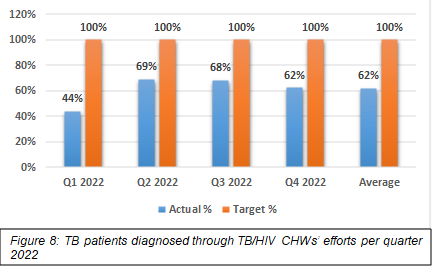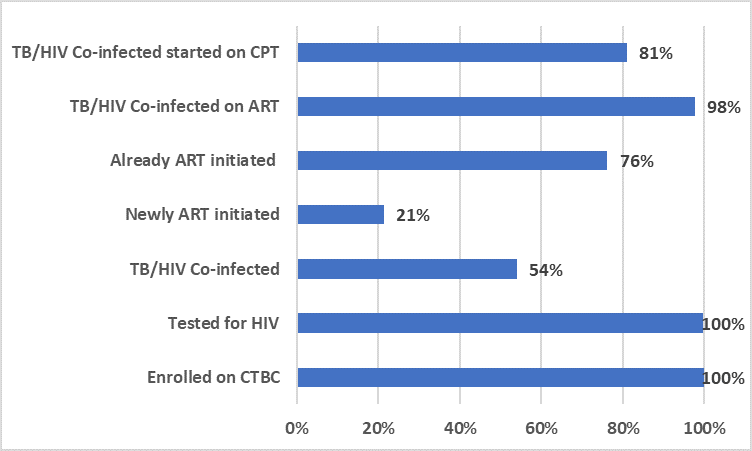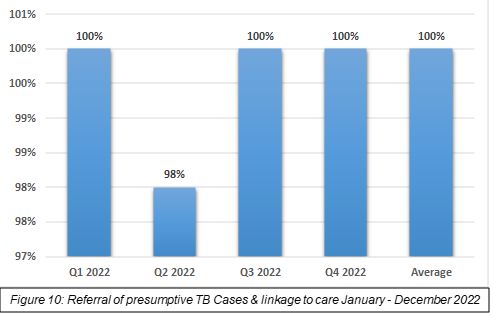- Who We Are
- What we do
- HIV / AIDS
- Tuberculosis (Integrated TB/HIV Services)
- TB Case detection, diagnosis & notification
- TB Infection Prevention & Control
- TB & HIV / AIDS Treatment Adherence & Support
- Community Education
- Capacity Building
- Community TB Care & Directly Observed Therapy Provision
- Referral & Linkage to Care
- Recording, Monitoring & Reporting
- Treatment, care & support TB in the mines (TIMS)
- Community Systems Strengthening
- Youth Programmes
- HIV Prevention among Key Populations
- Non Communicable Diseases
- Epidemics / Emergency Response
- Products
- Opportunities
- Resources
- Blogs
- Contact Us
TB Care and Prevention Services
WHO reported “Tuberculosis (TB) as a communicable disease that is major cause of ill health and one of the leading causes of death worldwide. Until the coronavirus (COVID-19) pandemic, TB was the leading cause of death from a single infectious agent, ranking above HIV/AIDS. For the first time in over a decade, TB deaths have increased because of reduced access to TB diagnosis and treatment in the face of the COVID-19 pandemic. Close to half of the people ill with TB missed out on access to care in 2020 and were not reported. Furthermore, the number of people provided with treatment for drug-resistant TB and TB preventive treatment dropped significantly (Global WHO 2021 Report). In recognition of the enormous health, social and economic impacts of the COVID-19 pandemic, this report also includes the COVID-19 pandemic setbacks experienced and how they affected the TB response. Despite the observed setbacks caused by COVID-19, ACHAP was able to re-strategized the planned TB/HIV services effectively, leading to the overall success of the programme.
ACHAP’s TB Care and Prevention Programme has 4 specific activities:
- New TB case diagnosis and notification
- Contact tracing & investigation
- Community TB care, treatment & patient support
- TB psychological and social support
The TB/HIV programme’s top priority during this reporting period was to restore access to and accelerate the provision of essential services to reduce the burden of TB and HIV in the community following the lessening of Covid-19 restriction such that, the vital TB treatment outcomes have improved to the acceptable levels. ACHAP embarked on the main mop-up community TB/HIV activities which include: active case finding, following contacts of all TB index patients, TB and ART loss to follow (defaulters) patients, missed appointments and interrupters as well as refer both PLHIV on Anti-Retroviral and Tuberculosis treatment interrupters for treatment re-initiation and or continuation to the nearest health facilities and ensure that they indeed, receive the recommended services.
This massive and vital exercise was conducted by CHWs (TB/HIV Volunteers) in the five (5) ACHAP supported districts, through door-to-door, outreach campaigns locally targeting hard to reach areas, farms, cattle posts, district’s neighbouring villages where most people had relocated during lockdowns. This exercise have saved the lives of ordinary individuals and communities by taking services to them as some index TB patients were identified, ART and TB interrupters and loss to follow as evidenced by the decrease in TB related mortality from 7% to 6% in 2021 and 2022 respectively. The incidence rate has been consistently low and assumed slight upward trend in the third quarter of 2022.
New TB case diagnosis and notification
Early TB case identification, diagnosis, treatment initiation and cure, are the priority concerns for ACHAP in the fight against TB since it is only in this way that infectious sources can be eliminated to achieve a Botswana free of TB by 2030. The primary goal of TB screening was to reach people who were not reached by the initiated pathway to detect TB disease and initiate treatment early.
The number of new TB cases registered in 2022 had increased gradually per quarter up to the end of September, assuming the slight upward trend, compared to 2021. Out of 260 new TB cases registered in 2022, 161 (62%) were diagnosed & notified through the community health workers’ efforts as community referrals, against a Global Fund target of 47%, translating into an outstanding performance of 132%. 14 of the 161 notified TB cases were People living with HIV (PLHIV).

Figure 8 shows fluctuating trend of TB cases diagnosed and notified by Community Health Workers Volunteers through various TB screening approaches against target. Average performance was 62% with the highest being 69% percent in quarter 2 and the lowest being 44% in quarter 1.
Community TB/HIV collaborative activities
The major role of Community TB/HIV Workers in this area was to offer routine HIV resting to all TB patients, refer them for testing, refer those who were TB/HIV co-infected to start ART and CPT to reduce opportunistic infections, promote treatment adherence, reduce the burden of TB and HIV disease, improve patients’ wellbeing and TB treatment outcome.
A higher percentage of people diagnosed with TB, were already on Anti-Retroviral Therapy (ART), this is an assurance that the “Treat All strategy” has made some strides in ensuring that all HIV positive patients are started on ART to improve their livelihood and wellbeing. During patient visitations for Directly observed therapy (DOT), TB/HIV co-infected patients are comprehensively supported for the two conditions, since they also need close monitoring for adherence purpose and observing for drug interactions, side effects for all drugs used, and the possibility of TB treatment failure or relapse. TB Treatment Supporters are oriented on these issues to maintain and sustain the required standard of care to all patients, including Drug Resistant TB cases.
Figure 9 below generally shows positive coverages against target. The coverages are high compared to the targets due to efficient patient education, counselling, effective referral system and cooperation of TB/HIV patients in general.

Figure 9: TB/HIV collaborative indicator performance: January – December 2022

Table 1: Treatment Care and Support Performance January – December 2022
Referral of presumptive TB cases & linkage to care
The current data on figure 10 below indicates high levels of referral linkage to services amongst presumptive TB cases. Community Health Workers consistently track referred patients to complete referral. The consistent use of ACHAP integrated referral slip for all presumptive TB cases had tremendously improved referral success both for general population and PLHIV at Infectious Disease Care Clinic (IDCC). Follow-ups for referred patients were done frequently and sometimes accompanying some of the sickly patients to ensure they reach the facility.

Activity 4: TB Psychological and Social Support
ACHAP’s community-based TB interventions address patients’ needs comprehensively, including social, economic and other challenges, and are geared towards improving patients’ overall wellbeing and treatment outcomes. All TB patients starting on treatment are educated and counselled for a period of 2 weeks before they are eligible for community TB care. These patients are capacitated on TB/HIV, their roles and responsibilities as partners in care, treatment adherence expectations, as well as being assisted to accept their TB or TB/HIV statuses.

Lessons learnt and best practices
- The collection of on-spot sputum and subsequent collections during the recommended periods played an integral part in managing transmission from all coughing TB presumptive cases to accelerate TB diagnosis and early treatment initiation, and improving cure rates in the districts overall.
- An inter-linked system to track patients; movement may be a solution to track all moved and transferred patients to allow patient monitoring up to the end of treatment or ease patient monitoring and evaluation on treatment by the referring health facility, which is the problem currently.
- There is a need to consistently be notified about the standard procedures in place as well as their roles and responsibilities during transfers from one district to another as well as understand the repercussions of deviating from laid out TB standard procedures to improve TB treatment outcomes.
- Consistency is key in engaging Community Health Workers in the provision of TB case management services, monitoring and prevention activities, bearing in mind shortage of government human resource and their inability to reach out to the communities.
- There is a need to consistently support private care clinics which diagnose and start patients on TB treatment, to enforce quality and standard TB case management from the start of treatment to the end.
Challenges and Recommendations
- COVID-19 slightly reversed the gains made prior to its toll in 2021/2022. Therefore, there is a need to have a contingency plan to guard against future pandemics and similar interruptions.
- TB in Botswana remains a major threat within communities because of stigma and discrimination. There is therefore a need to fight stigma through community participation to prevent and control the TB disease burden.
- Alcohol consumption while taking TB treatment is a notable challenge. Continued counselling and education are vital throughout the duration of treatment.
- The orientation of community leadership and soliciting their feedback on the ACHAP Global Fund community TB/HIV project helped to established a good rapport, enhanced their participation and active involvement on TB issues in their respective villages, and improved on their advocacy role and programme support across all the districts, as they now fully understand the aim of the project and its intended outcomes.
- TB prophylaxis among <5 years has been improved through identification of children as contacts during home visits and screening, however initiation has been slow. If initiation is improved, this programme will go a long way in reducing TB morbidity and mortality among children.
Conclusion
The current progress shows the impact that community TB/HIV health workers continue to make in the communities. They successfully bridge the gaps in contact tracing, enrolment of TB patients for Community TB Care, and provide effective implementation of TB/HIV collaborative activities.
The COVID-19 pandemic threatened to reverse recent progress made towards reducing the burden of TB disease if measures are not put in place.
Looking beyond the ACHAP Global Fund Phase 2 TB/HIV programme, there is a need to develop long-term sustainability through active implementation of a Behavioural Change Communication (BCC) strategy that will improve sharing, networking and internal and external relationships with communities and other partners implementing the TB/HIV programme for the betterment of the health status of the entire population in controlling and managing TB/HIV.

